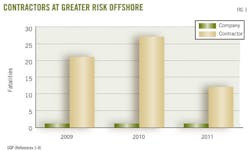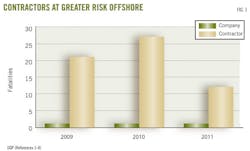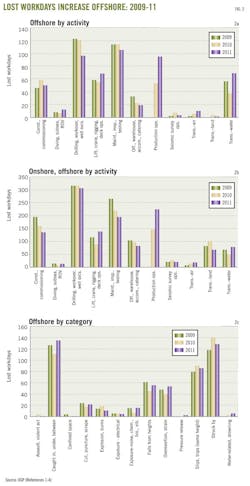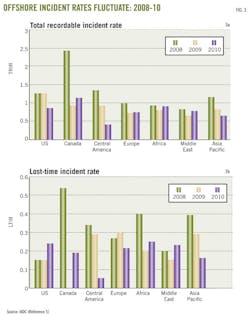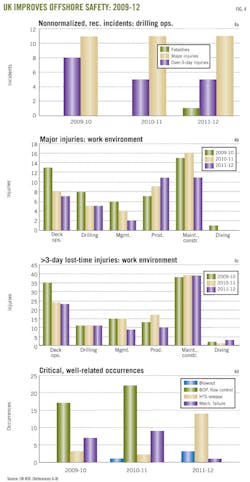EVALUATING OFFSHORE DRILLING RISKS – 2 (Conclusion): Global, regional statistics show continuing improvement
M. Sam Mannan
Ray A. Mentzer
Tony Rocha-Valadez
Anne Mims
Texas A&M University
College Station
The first article in this series introduced some of the efforts to identify leading and lagging indicators for process safety in offshore drilling operations. It also compared onshore and offshore safety statistics, using data from the UK International Oil and Gas Producers Association (OGP).
This conclusion augments OGP's findings by also looking at data from the UK Health and Safety Executive (UK HSE), the International Association of Drilling Contractors (IADC), and the Bureau of Safety and Environmental Enforcement (BSEE).
From these sources, we track trends in offshore safety and how to identify potential risk. Finally, we offer recommendations for reducing activities or operations in which incidents are frequent and for using indicators of high-consequence, low-frequency events, such as blowouts.
Contractors at risk
Offshore drilling statistics consistently show that contractor fatalities are more pervasive than company fatalities (Fig. 1). This reality is unfortunate but not surprising.
Contractors are more numerous, they are directly involved in drilling, and they are exposed more frequently to the hazards associated with offshore operations. Conversely, company personnel generally take a supervisory role and are not subjected to as much risk.
As we saw in Part 1, improvements have been made over the last 3 years, onshore and offshore, in fatality rates, total recordable incident (TRI) rates, and lost-time incident (LTI) rates. But there is still much work to be done.
Most offshore, lost-workday, recordable incidents are attributed to drilling, workover and well services, and maintenance services (Fig. 2a). This is consistent with trends found in OGP data that combined offshore and onshore data (Fig. 2b).
The three most frequent causes of offshore lost-workdays are struck by; caught in, under, between; and slips and trips (Fig. 2c). "Struck by" consistently is an issue onshore and offshore. However, "caught in, under, or between" is particularly a hazard offshore because of space constraints and platform configurations.
Regional fluctuation
Both OGP and IADC have categorized their statistics by region, and they are consistent when comparing offshore incidents from around the world (Figs. 3a and 3b). Various TRI and LTI rates for large, offshore-producing regions were examined. It is apparent that no one country or region consistently has higher rates. TRI rates are fairly constant for most countries, while LTI rates tend to fluctuate slightly more.
For example, the US saw its TRI rate either remain constant or improve slightly over the time horizon studied. The opposite is seen for the LTI rate, however, which increased markedly in 2010, while the corresponding TRI rate decreased. Canada's TRI and LTI rates fluctuate greatly year-to-year, which may be due in part to their smaller offshore operations compared with some of the other countries noted.
OGP and IADC's data include oil and gas producers worldwide, but the UK HSE only compiles data from companies operating within the UK. The UK HSE documents statistics differently than OGP, IADC, or any other safety organization. It does not document traditional OSHA rates but instead categorizes non-normalized recordable incidents into fatalities, major injuries, and injuries resulting in at least 3 lost workdays.
Major injuries are defined as incidents that disable a person to such an extent that he or she is never able to return to that particular job. More-than-3-day injuries are not as severe and individuals eventually return to their positions.
UK offshore safety
The UK has seen improvement in its offshore recordable incidents over the last 3 years. Major injuries decreased and there was only one fatality in that time. The UK has seen no continuous improvement in more-than-3-day injuries, however, which have remained flat (Fig. 4a).
The four most prolific causes of major injuries in the UK are maintenance and construction, production, deck operations, and drilling (Fig. 4b). Leading causes of more-than-3-day injuries are similar.
Unlike OGP and IADC, the UK HSE gathers statistics on offshore dangerous well occurances. There are four categories (Fig. 4c):
• Blowouts,
• Blowout preventer (BOP) and diverter operation to control flow.
• Unanticipated H2S releases.
• Mechanical failures of critical safety elements.
The UK has seen consistent improvement in the number of H2S releases 2009-11, from three to one. This is low compared with the other measured incidents, though the consequences can be fatal.
There is no specific trend regarding mechanical failure and BOP, diverter operation to control flow, which in simpler terms is a kick in the well. The data show that kicks are the largest factor in well-related incidents due to the overall large number of occurrences, which is roughly four times greater than any other type of occurrence.
While kicks are the leading category of incidents, the magnitude, severity, and effects of these incidents are often unknown because they are precursors to blowouts. In most cases, the kicks do not cause severe process-safety events or pose any threat when properly controlled.
The most important finding in UK well-related statistics is that the number of blowouts has steadily increased over the last 3 years. This indicates that either preventative measures are not being taken or workers are now more commonly recognizing and reporting blowouts.
GOM blowouts decrease
The BSEE publishes results on dangerous well occurrences and process-safety-related incidents each year for offshore drilling operations in the Gulf of Mexico. It breaks down blowouts into four categories:
• Uncontrolled flow underground.
• Uncontrolled flow at surface.
• Uncontrolled diverter flow (requires the use of a diverter system to direct uncontrolled flow from a shallow zone).
• Surface equipment failure.
As can be seen, the BSEE categorizes each blowout by where the uncontrolled flow occurs; in other words, the origin of the blowout.
Blowouts in the gulf have actually decreased during 2008-12, the opposite of the UK trend. However, the total number of blowouts is much higher due to the amount of activity in the gulf. Surface equipment failure due to loss of flow control has decreased as well. This is logical based on the lower number of total-loss-of-well-control occurrences each year.
Process-safety-related incidents in the gulf are most often by fires and explosions. There has been a 50% improvement during 2008-12, however. Collisions have also improved, but they occur less frequently.
Planning, procedures, maintenance
After analyzing the abundant data on offshore safety, what have we learned? Several conclusions can be drawn, from which future action to mitigate risk can be planned.
"Struck by" is an increasingly important category to monitor. It is now the leading cause of lost workdays in both offshore and onshore operations, though the root causes are different in these environments.
As we have seen, offshore struck-by incidents are primarily due to lifting, rigging and craning, and drilling. Therefore, efforts should focus on operating procedures and risk assessments, particularly for these hazardous activities.
Onshore, motor vehicle safety has a large effect on struck-by LTI and TRI rates. Proper measures regarding visibility of personnel should be taken when operating a vehicle. Motor vehicles with back-up sensors should be used when possible to prevent incidents. Workers should be trained on the proper processes that can prevent motor-vehicle incidents.
Dangerous well occurrences, although not published by many sources, are an indicator of blowouts. These can be reduced or mitigated by maintaining safety equipment, monitoring for indicators such as kicks or cement failures, and responding quickly when conditions are right for a blowout.
The number of kicks and their severity, as well as response time to kicks, can be leading indicators. They also help develop other leading indicators of blowouts.
The number of cement failures should be recorded and shared to display the long-term relationship between cement failures and blowouts.
Operators should take into account the harsh conditions of deepwater drilling when they choose the method to control a blowout. Dynamic kills and relief wells have been effective in deepwater conditions, requiring less time than other methods.
References
1. Safety Performance Indicators—2008 Data, International Oil & Gas Producers Association, 2009.
2. Safety Performance Indicators—2009 Data, International Oil & Gas Producers Association, 2010.
3. Safety Performance Indicators—2010 Data, International Oil & Gas Producers Association, 2011.
4. Safety Performance Indicators—2011 Data, International Oil & Gas Producers Association, 2012.
5. Incident Statistics Program—2012 Data, International Association of Drilling Contractors
6. Offshore Injury, Illness, Health and Incident Statistics—2009-10, UK Health and Safety Executive, 2010.
7. Offshore Injury, Illness, Health and Incident Statistics—2010-11, UK Health and Safety Executive, 2011.
8. Offshore Injury, Illness, Health and Incident Statistics—2011-12, UK Health and Safety Executive, 2012.
9. Loss of Well Control, Statistics and Summaries—2006-12, Bureau of Safety and Environmental Enforcement, 2012.
